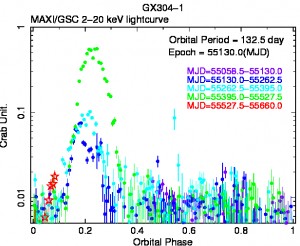The gas gain of the GSC unit #0 counter started to increase
suddenly on 2013 June 15 (56458 MJD) and reached 1.6 times higher than
that before on July 24 (56497 MJD) (see figure). The counter had been
operated in a reduced high-voltage mode (1550 V) to avoid breakdown.
However, the gain became almost the same as that in 1650 V. We reduced
the high voltage to 1484V on July 24 to keep the gas gain at the
standard level in 1550V. We exclude data of the GSC unit #0 after
2013 June 15 from the archived products on our web page. They will be
included later when the counter response becomes ready.
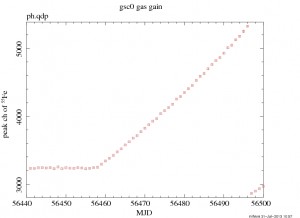
Increasing gas gain of GSC unit #0 counter
July 31st, 2013 by Tatehiro MiharaMAXI/GSC detection of an X-ray outburst from Be/X-ray binary pulsar GX 304-1
July 11th, 2013 by Tatehiro MiharaOn 2013 July 09 (MJD 56482), MAXI Nova-search system detected an
X-ray flux increase from a Be/X-ray binary pulsar GX 304-1. The
daily-averaged X-ray flux in 4-10 keV band reached 33 +- 19 mCrab on MJD
56481, and 57 +- 7 mCrab on MJD 56482. Using the orbital parameters (
Porb = 132.20 d; T0 = MJD 55554.75 ), the epoch when the brightening was detected (MJD 56482) corresponds to an orbital phase of ~0.02.
In prior to the current brightening, the source exhibited anomalous
activities; a weak flux increase at ~0.7 orbital phase on 2013 May 29
and a multi-peaked weak outburst at the previous periastron passage (MJD
56349) (please see the figure).
According to the previous researches (Nakajima et al. 2012; Caballero et
al. 2013), multi-peaked or double-peaked outbursts are often followed
by a giant outburst. Theoretically, the giant outburst is explained by
an interaction between the neutron star orbit and the warped Be-disc
(Okazaki et al. 2013).
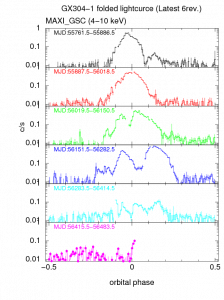
GSC data process updated to revision v1.4
June 13th, 2013 by Tatehiro MiharaThe process version of GSC data was updated to the revision v1.4 in all the archived products of the 336 monitoring X-ray sources on May 13, 2013, one month ago. MAXI/GSC gas counters have been operated with a high voltage of either 1650V (initial nominal) or 1550V (for long life). We have performed the detector response calibration for the 1550V data and revised the analysis software to be able to handle both high-voltage data. The light-curve process version had been updated from v0.3, 0.5, 0.8 to v1.4. The version of the spectrum data was updated from v0.3b to v1.4s. In some emergent targets, light-curve data are updated every 4 hours through a special analysis procedure whose version is v1.4.rkn. We continue the instrument calibration to improve errors on the response function.
We have been correcting errors in the web page for a month. If you find some, please let us know through the contact tab in the left column of the front page.
Cyclotron-line feature from GRO J1008-57 with MAXI-Suzaku ToO observation
January 24th, 2013 by Tatehiro MiharaAccording to the large flux increase observed with MAXI/GSC during the giant outburst in 2012 November, the MAXI team requested Suzaku ToO observation. It was performed at the outburst peak from 2012-11-20 (MJD 56251) 14:44 to 2012-11-22 5:21 with an exposure of 50 ks. The MAXI/GSC flux was 400 +- 11 mCrab in 4-10 keV. The flux with Suzaku was 6.8 x 10-9 erg cm-2 s-1 in 2-10 keV, and 2.65 x 10-8 erg cm-2 s-1 in 1-100 keV. The luminosity was 8.0 x 1037 erg s-1 in 1-100 keV at the 5 kpc distance (Coe et al. 1994).
Our preliminary analysis of the Suzaku HXD/PIN and GSO data revealed that the spectrum can be reproduced by an NPEX with a cyclabs model with a reduced chi squared (dof) = 0.94 (127). The derived parameters of the cyclotron-line feature are E_cyc = 75.5 (+2.5, -1.5) keV, W = 4.0 (+5.4, -4.0) keV, and D = 1.6 (+9.4, -0.6) with errors of 90% confidence limits. The feature existed throughout the entire phase of the apparent 93.6257 s spin period. The E_cyc were 77.7, 74.7, 75.5, and 76.2 keV for the devided spin phases of rise, peak, fall, and valley of the pulse shape, respectively.
Suzaku spectrum does not show any signature of cyclotron-line feature in 20-50 keV range. Thus, the feature at 76 keV is considered as the fundamental cyclotron line. It corresponds to a magnetic field strength of 6.6 x 1012 G, which is the highest among binary X-ray pulsars ever observed.
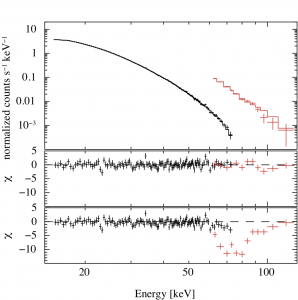
The spectra with Suzaku PIN and GSO fitted with a NPEX and cyclabs
model. The residuals in the bottom panel are without cyclabs model.
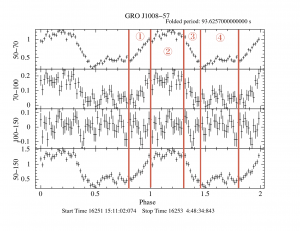
The pulse profile of GRO J1008-57. The pulse phases are divided into four phases : rise, peak, fall, and valley.
MAXI/GSC detection of an unexpected brightening from Be/X-ray binary pulsar GRO J1008-57
November 9th, 2012 by Motoki NakajimaMAXI/GSC is monitoring a peculiar X-ray activity of GRO J1008-57. The current long outburst started from August 2012. After the decay of the long outburst lasting for about 2 month, the flux turned into an increase again from MJD 56236 (2012-11-05). The flux reached 62 +- 7 mCrab (4-10 keV) on 2012-11-08 (MJD 56239) in 1-day bin. The latest 4-10 keV flux at 2012-11-09 03:00 UT reached 120 +- 9 mCrab in 4-hour bin. It is already as bright as the peak of the regular normal outburst at periastron. The Swift/BAT also detected the increase in 15-50 keV. According to the binary orbital parameters (Coe et al. 2007; Sootome et al. 2012), the present flare corresponds to ~0.3 orbital phase. Such a bright flare has not been recorded at this orbital phase.
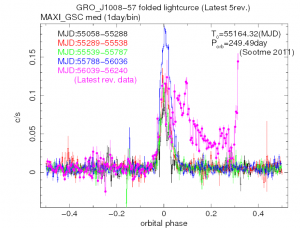
Folded light curve of GRO J1008-57 by its binary orbital period of 249.49 day.
Does a double-peaked outburst lead to a giant outburst in GX 304-1 as A 0535+26 ?
September 25th, 2012 by Tatehiro MiharaThe Be/X-ray binary pulsar, GX 304-1, started brightening on
September 17, suggesting that the source now entered a new outburst. The
X-ray flux reached 40 +- 5 mCrab (4-10 keV) on September 23. It was 15
days earlier than that expected from the orbital period of 132.5 days
and the phase of the outburst onset of the previous 11 outbursts.
The figure shows folded MAXI/GSC X-ray light curves by the orbital
period for GX 304-1 (in red) and A 0535+25 in 2009 (in gray). The
Swift/BAT curves are also overlaid. The shapes of double peaks and a
precursor agree very well between the two pulsars. Then, a giant
outburst may follow in GX 304-1 in mid-October.
(by Nakajima and Mihara)
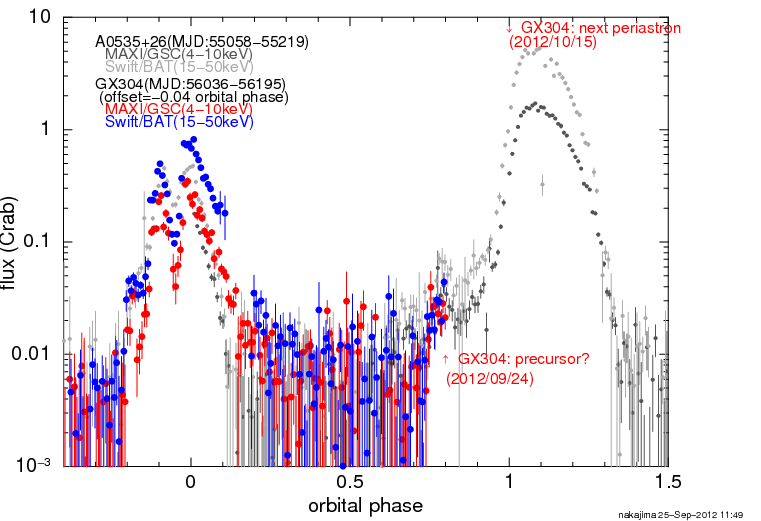
Folded light curves of GX 304-1 (red) and A 0535+26 (gray) by their orbital periods. Double-peaked outbursts of the two are similar, and now GX 304-1 is tracing the precursor in prior to the giant outburst.
On-demand data archive is now open to public
November 8th, 2011 by Tatehiro MiharaOn-demand data of MAXI/GSC is available. You can get spectrum of any sky position of any time. Please visit
There is also a short-cut “on-demand data” on the maxi-riken top page (http://maxi.riken.jp/top), or you can select “Data Products” tab and click “go to on-demand page”.
The data are limited to those taken with 1650-V counters since 2009 October 31 to 2 days ago excepting for the GSC_3. Please read the notes in “About this page” before you start the analysis.
MAXI detection of a super-burst from EXO 1745-248 in Terzan 5
November 1st, 2011 by Tatehiro MiharaWe analyzed the MAXI/GSC light curve of an X-ray burst from EXO
1745-248 in Terzan 5 reported in Atel #3714, #3718, #3720 and found
that the initial peak at MJD 55858.53 decayed exponential with an
e-folding time of 10 hour.
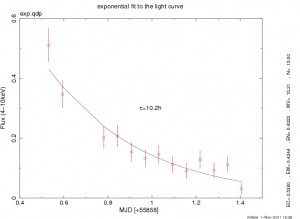 If the emission is a blackbody radiation, the temperature can be estimated from the hardness of two energy bands.
If the emission is a blackbody radiation, the temperature can be estimated from the hardness of two energy bands.
MJD 4-10/2-4 keV kT
[keV] 10-20/4-10 keV kT [keV]
55858.53
2.9 2.9 +-
0.8 0.32 2.4
+- 0.6
55858.59
1.5 1.7 +-
0.4 0.19 2.0
+- 0.8
55858.78
1.05 1.4 +-
0.4 0.50 2.8
+- 1.0
55858.84
1.24 1.58 +-
0.5 0.37 1.85 +- 0.8
55858.91
1.06 1.43 +- 0.5
0.19 1.83 +- 1.5
55858.97 1.03
1.40 +- 0.5
0.06 1.80 +- 3.9
(Errors are 1-sigma.)
The values derived from 4-10/2-4 keV and 10-20/4-10 keV
are consistent with each other. It showed a softening from 2.9 keV in the beginning to 1.5 keV in the end.
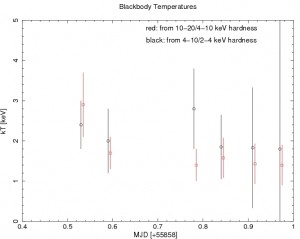
The fluence is 2.4 x 1042 erg in 2-10 keV assuming 8.7 kpc distance (Cohn et al. ApJ 571 818 (2002)). Using H burning energy of 6 x 1018 erg/g, the mass of H is 4.0 x 1023 g. Using the average flux of 10 mCrab (1.7 x 1036 erg/s, 9.0 x 1015 g/s), the reputation time is calculated to be 510 yr. (<- It was a mistale. Correctly 510 days. If we use C-burning energy it becomes 5100 days = 14 yrs. by TM 2011.11.16)
The sphere radius of the blackbody is 6.3 km with using 2 keV and 6.8 x 1037 erg/s at the peak.
These results (e-folding time, temperature, softening, fluence, and radius) are typical as a super-burst from low-mass X-ray binaries.
Atel #3729
Archived light-curve data is available at
MAXI/GSC detection of an X-ray burst from the posion consistent with the globular cluster M15
June 7th, 2011 by Mikio MoriiMAXI/GSC detected an X-ray burst at the scan transit centered at UT 2011-06-05T00:10:03.
The burst was detected at least for 30 seconds within the 62 seconds triangular transit response of MAXI/GSC.
The nominal location of the source, assuming that the source flux was constant over the transit
(which probably was not), is determined as
(R.A., Dec) = (+322.76 deg, +12.03 deg)
= (21 31 3, +12 01 44)(J2000)
with a rectangular 90% statistical error box with the following corners:
(R.A., Dec) = (+322.65 deg, +12.24 deg)
= (21 30 35, +12 14 7)(J2000)
(R.A., Dec) = (+322.93 deg, +12.19 deg)
= (21 31 42, +12 11 14)(J2000)
(R.A., Dec) = (+322.87 deg, +11.82 deg)
= (21 31 28, +11 49 28)(J2000)
(R.A., Dec) = (+322.59 deg, +11.87 deg)
= (21 30 21, +11 52 20)(J2000)
There is additional systematic uncertainty of 0.2 degree (90% containment radius).
This position is consistent with that of the globular cluster M15,
whose position is (R.A, Dec) = (322.49 deg, 12.17 deg).
The burst flux was 220 +-20 mCrab in the 4 – 10 keV band.
This burst is though to be the type I X-ray burst, because the softening of the spectrum was observed.
As reported in ATEL #3363, #3378, #3393, this source has been active recently.
MAXI data process has recovered.
March 30th, 2011 by Tatehiro MiharaWe have returned to the regular data process since March 25. The data between March 11-24 are to be filled succeedingly. In addition, we started a frequent update service in every 4 hours, first for 4U 1608-52 (ATel #3237) and Swift J164449.3+573451 (ATel #3244).
MAXI data stopped by the earthquake.
March 14th, 2011 by Tatehiro MiharaThe ISS-opration building in JAXA Tsukuba space center was damaged by the earthquake on March 11, 2011. The building contains the computers which receive MAXI telemetry data from NASA and store them. The computers have stopped since then. MAXI data also stopped and we can not issue alerts. We think it will take more than a week for the recovery. The MAXI itself in orbit has no problem and continues the observation. The data will be sent to Tsukuba space center afterwards.
Be X-ray binary pulsar A0535+262 started a new giant outburst.
February 23rd, 2011 by Tatehiro MiharaMAXI/GSC has detected a new outburst from Be transient X-ray binary pulsar A0535+262 (Atel #3166). The figure shows the lightcurve folded with 110.2-day orbital period (Moritani 2010) in the 1.5 yr MAXI observations. Orbital phase zero corresponds to the periastron. The current light curve (orange) traces the previous giant outburst (blue) in December 2009 very well. (It may be a little smaller this time). The He I double line indicates a new gas-disk ejection from the Be star (Atel #3176). No strong precursor before MJD55601 (= Feb 9) may indicate that the gas was ejected very recently just before the “He I double line” observation (Feb 5). The short (1.2 yr) recurrent time shows that the Be star has become active.
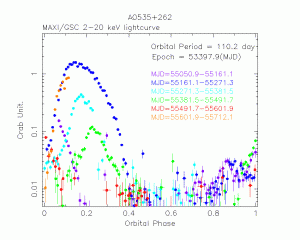
MAXI/GSC detects a new activity from binary X-ray pulsar GX 304-1
December 10th, 2010 by Motoki NakajimaMAXI/GSC detected a new activity from transient pulsar GX 304-1. The figure shows the lightcurve folded with 132.5-day orbital period. As shown in below figure, the current flux increase is about 1-week earlier than that of the previous outburst within the orbital cycle of 132.5-day period. Thus, the current activity may be a precursor, or an onset of an anomalous giant outburst that occurs out of regular recurrent phase. We have reported this news to Astronomer’s Telegram #3075.
